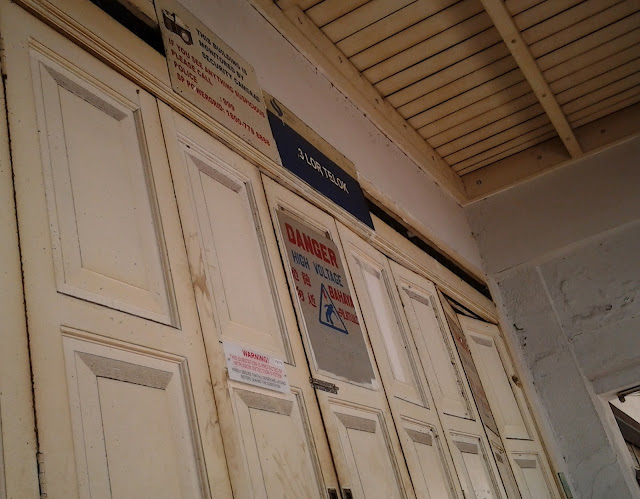 |
A haven for food lovers, but a nightmare for parking. This is what this area means to me -- usually. So the smart thing to do is to take a bus. In my younger days, the Red House Bakery (now under restoration, to the left of the picture) was a really interesting place to me. You could choose your bread or whatever morsel and then have them in peace somewhere in the bowels of this bakery which looked small on the outside but had courtyards once you entered. Established in 1925 it was closed in 2003, deemed unsafe. A Jew started the bakery shop which was later taken over by a Hainanese seaman who apparently paid only $600 as "coffee money" to take over the bakery. That was in the 1930s. Information taken from Infopedia. |
Sunday 22 November 2015
East Coast Road
Sunday 6 September 2015
The "mirrors" of Syed Alwi Road
 |
The row of shophouses at Syed Alwi Road towards Victoria Street (which runs more or less parallel to Jalan Besar). Syed Alwi Road is a rather long road. The row at this stretch has decorative "mirror" motifs with windows as the reflective panel instead of mirrors. Similar designs (though not for windows) can be found in other shophouses in the area, like the one below along Jalan Besar.According to a write-up by the National Heritage Board, Syed Alwi Road was near a swampland (as late as 1924). Built in 1850s, it was originally named Jalan Bahru. Later, it was named after Justice of Peace Syed Alwi, son of Syed Ali who bought 70 acres of swampy land around the region, and noted for constructing wells at Selegie Road and even in Telok Ayer and Mohamed Ali Lane in Chinatown, to provide water for the public. Read about its history here: http://www.nhb.gov.sg/places/trails/jalan-besar/trail-sites/historic-sites/syed-alwi-road. |
 |
Mirror, mirror on the wall... Decorative motifs on a row of shophouses at corner of Kitchener Road where it meets Jalan Besar. |
Sunday 16 August 2015
The "ship bows" of Lorong Telok
 |
The "ship bow" at the junction of Lor Telok and Circular Road. |
 |
Low rise two-storey shophouses interspersed with taller ones at Lor Telok. |
Tuesday 21 July 2015
'Sky River' clan association at Ann Siang Road
 |
Two more letter boxes (for different floors), and more nice tiles. |
Amoy Street
 |
Once known for its opium dens, Amoy Street also had one of Singapore's earliest free schools. The Chui Eng School was founded by a Straits Chinese, Tan Kim Seng in 1854. It closed in 1954 but was conserved. Today, it is occupied by the Ju Chun Yuan Restaurant. Founded in 1865, this is the restaurant which created the famous Chinese dish, Buddha Jumps Over the Wall in 1876.
 |
Sunday 19 July 2015
Geylang Road
 |
Some renovation going on here. Also Lorong 15, |
 |
Spruced up, these tiles will be quaint and charming. |
Monday 13 July 2015
Telok Ayer Street
 |
Telok Ayer Street, a must walk. Nice mix of shophouses with interesting eateries, including The Muffinery shown in the picture (to the right, near the gable). |
 |
The Hokkien Huay Kuan at Telok Ayer Street. |
Monday 29 June 2015
Upper Cross Street
 |
Upper Cross Street, near the junction at South Bridge Road. Pics taken on a very hot Sunday, 28 June, 2015. |
Tuesday 6 January 2015
Selegie Road
 |
I guess I can't pass this off as a shophouse. This building, 100 Selegie Road, is now used by the International Institute of Tea Culture. It was once a upon a time, a landmark in this area, being the Tiger Balm Building. You can see a picture of how it looked like in its days of glory at http://kaufmann-mercantile.com/tiger-balm/. A 4th floor has been added to the building, and the tiger that was so majestic gracing its facade is gone. The building now looks like a block of chocolate, but I guess, it's the colour of tea. Pic taken in Jan, 2015. |
Happy Short Street
Prinsep Street
 |
Wonder why the Lor Payah signboard (and the Stop sign) are stuck in the middle of this construction site at Prinsep Street :) There is a Lorong Payah nearby, but it already has its own sighboard. |
Thursday 1 January 2015
Keong Saik Road
 |
Picture taken at the junction of Keong Saik Road and Kreta Ayer Road. The row of shophouses (with the spiral staircases at the back), was built in 1929 -- Hotel 1929 opened there in 2003. The Sri Layan Sithi Vinayagar Temple (fore, right) was built in 1925. It has a rich history. The idol of Lord Vinayagar was brought to Singapore by a soldier from India who left the idol behind for the community to build a temple. As the temple was near the General Hospital, its worshippers were mainly hospital and prison staff. (There was a prison at Outram Road -- the first one, for civil offences was built in 1847, with another for criminals added in 1882. The prisons were demolished in 1970 and in their place, a public housing estate called the Outram Park Complex which was also demolished in the early 2000s.) I don't remember the prisons at all... do you? I do remember Outram Park Complex -- there was the famous char kway teow... also one Chinese physician who operated a clinic there. He was rather well known. |
Subscribe to:
Posts (Atom)



















